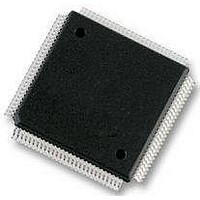MC912D60CCPVE Freescale Semiconductor, MC912D60CCPVE Datasheet - Page 74

MC912D60CCPVE
Manufacturer Part Number
MC912D60CCPVE
Description
IC MCU 16BIT 112-LQFP
Manufacturer
Freescale Semiconductor
Series
HC12r
Datasheet
1.MC912D60ACFUE8.pdf
(460 pages)
Specifications of MC912D60CCPVE
Core Processor
CPU12
Core Size
16-Bit
Speed
8MHz
Connectivity
CAN, MI Bus, SCI, SPI
Peripherals
POR, PWM, WDT
Number Of I /o
68
Program Memory Size
60KB (60K x 8)
Program Memory Type
FLASH
Eeprom Size
1K x 8
Ram Size
2K x 8
Voltage - Supply (vcc/vdd)
4.5 V ~ 5.5 V
Data Converters
A/D 16x8/10b
Oscillator Type
Internal
Operating Temperature
-40°C ~ 85°C
Package / Case
112-LQFP
Processor Series
HC912D
Core
HC12
Data Bus Width
16 bit
Data Ram Size
2 KB
Interface Type
CAN, SCI, SPI
Maximum Clock Frequency
8 MHz
Number Of Programmable I/os
86
Maximum Operating Temperature
+ 85 C
Mounting Style
SMD/SMT
3rd Party Development Tools
EWHCS12
Minimum Operating Temperature
- 40 C
On-chip Adc
10 bit, 8 Channel
Lead Free Status / RoHS Status
Lead free / RoHS Compliant
Available stocks
Company
Part Number
Manufacturer
Quantity
Price
Company:
Part Number:
MC912D60CCPVE
Manufacturer:
FREESCAL
Quantity:
203
Company:
Part Number:
MC912D60CCPVE
Manufacturer:
Freescale Semiconductor
Quantity:
10 000
- Current page: 74 of 460
- Download datasheet (5Mb)
Operating Modes and Resource Mapping
5.4 Background Debug Mode
Technical Data
74
Background debug mode (BDM) is an auxiliary operating mode that is
used for system development. BDM is implemented in on-chip hardware
and provides a full set of debug operations. Some BDM commands can
be executed while the CPU is operating normally. Other BDM
commands are firmware based, and require the BDM firmware to be
enabled and active for execution.
In special single-chip mode, BDM is enabled and active immediately out
of reset. BDM is available in all other operating modes, but must be
enabled before it can be activated. BDM should not be used in special
peripheral mode because of potential bus conflicts.
Once enabled, background mode can be made active by a serial
command sent via the BKGD pin or execution of a CPU12 BGND
instruction. While background mode is active, the CPU can interpret
special debugging commands, and read and write CPU registers,
peripheral registers, and locations in memory.
While BDM is active, the CPU executes code located in a small on-chip
ROM mapped to addresses $FF20 to $FFFF, and BDM control registers
are accessible at addresses $FF00 to $FF06. The BDM ROM replaces
Operating Modes and Resource Mapping
Special Expanded Narrow Mode — This mode can be used
for emulation of normal expanded narrow mode. Ports A and B
are used for the16-bit address bus. Port A is used as the data
bus, multiplexed with addresses. In this mode, 16-bit data is
presented one byte at a time, the high byte followed by the low
byte. The address is automatically incremented on the second
cycle.
Special Peripheral Mode — The CPU is not active in this
mode. An external master can control on-chip peripherals for
testing purposes. It is not possible to change to or from this
mode without going through reset. Background debugging
should not be used while the MCU is in special peripheral
mode as internal bus conflicts between BDM and the external
master can cause improper operation of both modes.
MC68HC912D60A — Rev. 3.1
Freescale Semiconductor
Related parts for MC912D60CCPVE
Image
Part Number
Description
Manufacturer
Datasheet
Request
R
Part Number:
Description:
Manufacturer:
Freescale Semiconductor, Inc
Datasheet:
Part Number:
Description:
Manufacturer:
Freescale Semiconductor, Inc
Datasheet:
Part Number:
Description:
Manufacturer:
Freescale Semiconductor, Inc
Datasheet:
Part Number:
Description:
Manufacturer:
Freescale Semiconductor, Inc
Datasheet:
Part Number:
Description:
Manufacturer:
Freescale Semiconductor, Inc
Datasheet:
Part Number:
Description:
Manufacturer:
Freescale Semiconductor, Inc
Datasheet:
Part Number:
Description:
Manufacturer:
Freescale Semiconductor, Inc
Datasheet:
Part Number:
Description:
Manufacturer:
Freescale Semiconductor, Inc
Datasheet:
Part Number:
Description:
Manufacturer:
Freescale Semiconductor, Inc
Datasheet:
Part Number:
Description:
Manufacturer:
Freescale Semiconductor, Inc
Datasheet:
Part Number:
Description:
Manufacturer:
Freescale Semiconductor, Inc
Datasheet:
Part Number:
Description:
Manufacturer:
Freescale Semiconductor, Inc
Datasheet:
Part Number:
Description:
Manufacturer:
Freescale Semiconductor, Inc
Datasheet:
Part Number:
Description:
Manufacturer:
Freescale Semiconductor, Inc
Datasheet:
Part Number:
Description:
Manufacturer:
Freescale Semiconductor, Inc
Datasheet:











